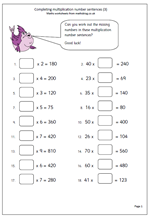 This is the third worksheet in the mini series looking at using different strategies to work out missing numbers in multiplication number sentences. Again, it is worth pointing out that people who say they, ‘can’t do maths’, probably don’t have a wide range of mental strategies to tackle questions. All the questions on this worksheet look very similar but if you analyse how the brain works to answer them you will see what I mean.
This is the third worksheet in the mini series looking at using different strategies to work out missing numbers in multiplication number sentences. Again, it is worth pointing out that people who say they, ‘can’t do maths’, probably don’t have a wide range of mental strategies to tackle questions. All the questions on this worksheet look very similar but if you analyse how the brain works to answer them you will see what I mean.
Let’s look at a couple of examples:
1. Question: ? x 6 = 360
I instantly recognise the relationship between 6 and 36, knowing that 6 x 6 = 36. it then becomes very easy to multiply by 10 to reach the answer 60. This is all done in less than a second.
2. Question: 26 x ? = 104
This takes a little longer and at first glance I’m not certain. I then realised that 25 is a quarter of 100, so 25 x 4 is 100,therefore 26 x 4 would be 104.
In the first question I am making use of knowing the 6x table. In the second question I am rounding a number, working out the answer and adjusting.
Of course, there are other ways, probably just as good and don’t forget to ask the children how they worked out the answers. You might be surprised!